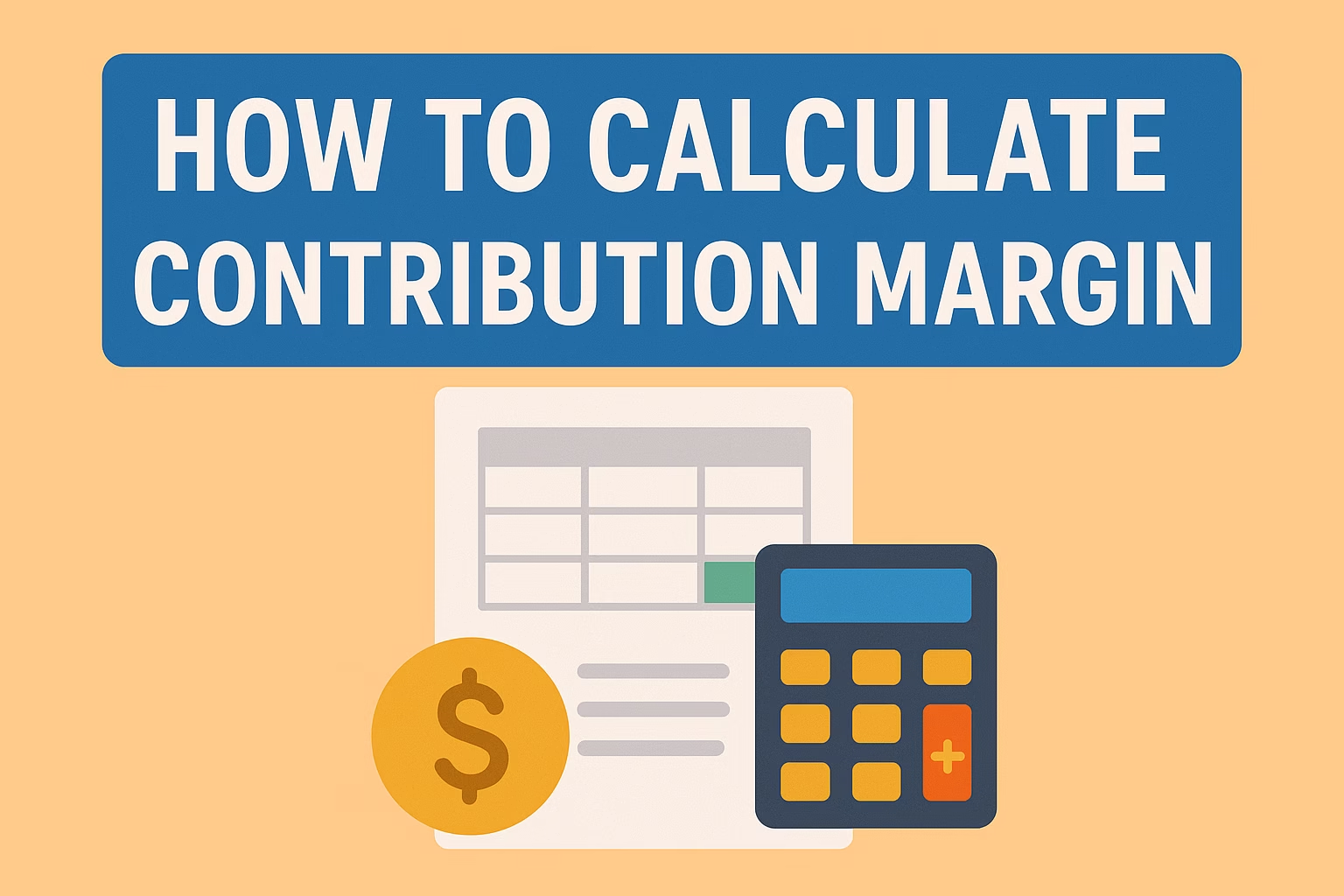Running a small shop or managing a sales team means making smart calls every day. Price changes, promo ideas, new products, all of it affects your bottom line. That is why understanding contribution margin is such a win. It shows how much money from each sale is left to cover fixed costs and profit after variable costs are paid.
So, how do you calculate contribution margin? Use a simple formula: Contribution Margin equals Sales minus Variable Costs. You can do it per unit, total, or as a ratio. The ratio is Contribution Margin divided by Sales, which helps you compare products and channels.
This metric makes pricing clearer, supports break-even analysis, and helps you spot which items deserve more love. It highlights waste, protects your margins during discounts, and guides decisions when costs move. If you have ever wondered why cash gets tight even when sales look strong, contribution margin often holds the answer.
In this post, you will learn what counts as variable vs. fixed costs, how to run the math with clean examples, and how to use the results to set prices and hit your break-even point. We will keep the steps simple, the terms plain, and the actions clear. By the end, you will know how to calculate contribution margin and use it with confidence.
What Is Contribution Margin and Why Does It Matter?
Contribution margin tells you how much of each dollar of sales is left after variable costs. That leftover amount covers fixed costs, then becomes profit. You can look at it per unit or as a percentage of sales. Quick preview: Contribution Margin = Sales Revenue minus Variable Costs, and the ratio is Contribution Margin divided by Sales Revenue.
Think about a lemonade stand. You sell a cup for $2. Lemons, sugar, and cups cost $0.80. Your contribution margin is $1.20 per cup. That $1.20 pays for your table and sign, then flows to profit.
This metric helps you choose prices, rank products, and protect profit during discounts. Use it to focus on what actually earns money.
Key Components: Sales Revenue and Variable Costs
Start with sales revenue, the total money from selling your goods or services before any costs. It is the top line of each product or order.
Then subtract variable costs, which rise and fall with production or sales volume. Common examples:
- Raw materials and packaging
- Direct labor tied to units made or hours billed
- Shipping and payment processing fees
- Sales commissions and usage-based software
Contrast that with fixed costs. Rent, salaries for admin staff, insurance, and software subscriptions do not change with unit volume in the short term. You do not subtract fixed costs when computing contribution margin. You use the margin to see how much is available to cover those fixed bills.
Understanding these pieces gives you sharper insight. You can spot products that look popular but drain cash, compare channels on equal footing, and plan price moves with less guesswork.
Contribution Margin Ratio vs. Per Unit: Which to Use?
Use the per unit contribution margin when you need product-level clarity. It shows the dollars earned per item sold after variable costs. It is perfect for pricing a new SKU, negotiating supplier costs, weighing a discount, or deciding whether to keep or drop a product. Pros: simple to explain, great for frontline decisions, easy to model what-if changes like a $0.10 cost increase.
Use the contribution margin ratio when you need a view of overall performance or scale. It shows what percent of sales you keep after variable costs, across a product line, channel, or the whole business. Pros: compares different products fairly, works well for forecasting, helps with break-even, and reveals how growth will translate into profit. If your ratio is strong, adding volume often pushes more dollars to the bottom line without raising fixed costs.
How to Calculate Contribution Margin: A Simple Step-by-Step Guide
You already know the core idea: contribution margin equals sales minus variable costs. Now put it to work. Follow these steps to pull clean data, run the math per unit and in total, then convert it to a ratio you can compare across products and channels.
Step 1: Gather Your Sales and Cost Data
Start with reliable numbers. You need sales and variable costs for the same period or product.
- Find sales: Pull totals from invoices, POS reports, or your sales dashboard. Exports from QuickBooks, Xero, Shopify, or Stripe reports work well.
- Find variable costs: Use your expense tracker or cost-of-goods detail. Look for costs that change with units sold.
Common variable costs:
- Materials and packaging
- Direct labor per unit or per billable hour
- Shipping, merchant fees, and sales commissions
- Usage-based software or APIs tied to orders
Use a spreadsheet or your accounting software to tag costs as variable or fixed so you do not mix them.
Avoid these mistakes:
- Mixing fixed with variable: Rent, salaried admin, and software subscriptions are fixed. Do not subtract them here.
- Mismatched time frames: If sales are monthly, use monthly variable costs.
- Average cost traps: If input prices changed, update the variable cost per unit.
Quick setup tip: create columns for Product, Units, Sales, Variable Cost per Unit, Total Variable Cost, and Contribution Margin.
Step 2: Subtract Variable Costs from Sales
Use the basic formula with both per unit and total views.
- Per unit: Contribution Margin per Unit = Selling Price per Unit minus Variable Cost per Unit.
- Total: Total Contribution Margin = Total Sales minus Total Variable Costs.
Example:
- You sell 100 widgets at $10 each. Sales = $1,000.
- Variable cost per unit is $6. Total variable cost = 100 x $6 = $600.
- Per unit margin = $10 minus $6 = $4.
- Total contribution margin = $1,000 minus $600 = $400.
That $400 goes to cover fixed costs first, then profit.
Step 3: Calculate the Margin Ratio for Bigger Picture Insights
The ratio tells you what percent of sales you keep after variable costs.
- Formula: Contribution Margin Ratio = (Contribution Margin divided by Sales) x 100.
Using the widget example:
- Contribution margin = $400, sales = $1,000.
- Ratio = ($400 divided by $1,000) x 100 = 40%.
How to read it:
- Higher ratio: More sales dollars are available to cover fixed costs and profit.
- Lower ratio: Less room for price cuts, rising costs, or commissions.
Use the ratio to compare products, channels, or periods. If a product shows 55% and another shows 22%, the 55% item will scale profit faster, assuming fixed costs stay steady.
Contribution Margin Calculator Calculate profitability and break-even points instantly →Real-Life Examples and Tips for Using Contribution Margin Effectively
Use contribution margin to make clean pricing calls, drop weak items, and plan growth. Keep the math simple, then act on the signals. Here are quick examples to ground the concept.
- Retail product example: A boutique sells candles for $18. Wax, wick, jar, and packaging cost $7 per unit. Contribution margin per unit is $11. Ratio is $11 divided by $18 equals 61%. This item can handle a small discount and still help cover rent.
- Service business example: A freelance designer charges $150 per logo. Variable costs are $15 for processing fees and $10 for stock assets. Margin is $125, ratio is 83%. This tells you rush fees or small discounts still leave plenty to cover your fixed costs.
- Break-even example: A gym sells $40 monthly passes with a $10 variable cost per member. Contribution margin is $30. If fixed costs are $12,000 per month, break-even units are $12,000 divided by $30 equals 400 members. Past 400, most dollars flow to profit.
Example: Calculating for a Coffee Shop Product
You sell a latte for $5. Variable costs are $2 per cup (beans and milk).
- Per unit margin: $5 minus $2 equals $3.
- Contribution margin ratio: $3 divided by $5 equals 60%.
What to do with it:
- Price testing: If milk costs rise by $0.25, margin drops to $2.75. You could raise price to $5.25 to keep the 60% ratio.
- Menu strategy: Push high-margin add-ons like flavored syrups with low extra cost. If a specialty drink uses pricey ingredients and drops ratio below 40%, set a higher price or shrink the portion.
- Discount guardrails: A 10% off promo cuts price to $4.50. Margin becomes $2.50, ratio 56%. Still healthy, but do not stack more discounts.
Common Pitfalls to Avoid in Your Calculations
Mistakes creep in when inputs are messy. These fixes will keep you confident.
- Hidden variable costs: Forgetting cups, lids, merchant fees, or delivery charges undercounts costs. Build a checklist per product and update quarterly.
- Outdated data: Supplier prices change often. Refresh variable cost per unit when invoices shift by more than 3%.
- Mixing fixed and variable: Salaried staff and rent are fixed. Do not subtract them in the margin. Use margin to cover them.
- Averaging across unlike items: Group by product or category. Do not blend regular lattes with seasonal specials.
- Seasonal swings: Adjust for holiday surges and slow months. Track ratio by month to catch pattern changes.
Smart habits:
- Review margins monthly, deep dive each quarter.
- Pair with gross margin and profit per labor hour for a fuller view.
- If numbers look off, ask your accountant to validate your cost buckets.
Conclusion
You now have a simple path to clear margin math. Gather clean sales data, separate variable from fixed costs, subtract variable costs from sales, then check both the per unit margin and the ratio. Use those numbers to price with confidence, guard discounts, and plan break-even and growth.
Do not wait for perfect data. Run a quick version today, even for one product or service. Small improvements, like a price tweak or a supplier change, can lift profit fast.
Put this into action this week. Tag your costs, rerun your top three items, and set guardrails for promotions. Share what you find in the comments, or subscribe for more practical finance tips.
Strong decisions start with simple math. Use contribution margin to keep your shop focused, steady, and profitable.



